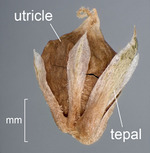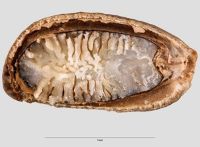Content is from Kirkbride et al. 2006Kirkbride et al. 2006:
Kirkbride JH, Jr, Gunn CR, and Dallwitz MJ. 2006. Family guide for fruits and seeds, vers. 1.0. Accessed September 2020-January 2022. URL: https://nt.ars-grin.gov/seedsfruits/keys/frsdfam/index.cfm ., without modification.
Updates are forthcoming.
 and mesocarpmesocarp:
and mesocarpmesocarp: absent and endocarpendocarp:
absent and endocarpendocarp: exposed.
exposed.
Fruits: Pistil(s) compound; 1; 1-pistillate; with carpels united. Fruit anthocarpanthocarp:
simple or compound and including some tissue of non-ovarian origin (accessory tissue) ; simple; glans (Hernandia Spjut Fig. 34D-E), or pseudosamara (Gyrocarpus Spjut Fig. 45B); without persistent central column; within accessory organ(s); within inflated calyxcalyx:
; simple; glans (Hernandia Spjut Fig. 34D-E), or pseudosamara (Gyrocarpus Spjut Fig. 45B); without persistent central column; within accessory organ(s); within inflated calyxcalyx:
the outer whorl of the perianth; all the sepals of a flower , or tepalstepal:
, or tepalstepal:
a member of the perianth, when it cannot be differentiated into a calyx and corolla , or bracteoles (opposing becoming wing-like); persistent; soft calyxcalyx:
, or bracteoles (opposing becoming wing-like); persistent; soft calyxcalyx:
the outer whorl of the perianth; all the sepals of a flower (assumed); 1-seeded; 1-seeded; with 1-carpellate; not sulcatesulcate:
(assumed); 1-seeded; 1-seeded; with 1-carpellate; not sulcatesulcate:
surface relief—having one or more elongate, relatively narrow and shallow depressions or grooves ; in transection tereteterete:
; in transection tereteterete:
approximately circular in cross section; width and thickness approximately equal
 ; apexapex:
; apexapex:
the point farthest from the point of attachment, or the "tip" of an organ not beaked; indehiscentindehiscent:
not beaked; indehiscentindehiscent:
not opening on its own, as in a fruit
 . Epicarpepicarp:
. Epicarpepicarp:
outer layer of fruit wall or pericarp, if divided into layers; note here used synonymously with exocarp brown (all shades) (at least); dulldull:
brown (all shades) (at least); dulldull:
reflecting only a low proportion of incident light, with no apparent sheen (at least); durable; not glabrousglabrous:
(at least); durable; not glabrousglabrous:
without hairs
(with hairs) (assumed); hairs not glandularglandular:
surface relief—covered with small, raised secretory glands, regular or irregularly shaped, translucent or opaque, and maybe distinctly colored ; without armature; not smooth, or smooth; longitudinally ribbedribbed:
; without armature; not smooth, or smooth; longitudinally ribbedribbed:
surface relief—wide, prominent, linear ridges that are generally rounded and longitudinally situated on the surface , or wrinkledwrinkled:
, or wrinkledwrinkled:
surface relief—shallow, irregular folds and furrows covering the surface; appearing overall though crumpled and then spread out ; without wing(s), or with wing(s); 1–2-winged; with wing(s) apicalapical:
; without wing(s), or with wing(s); 1–2-winged; with wing(s) apicalapical:
at or pertaining to the end of the seed or fruit distal from its point of attachment (i.e., base)
, or laterallateral:
(of embryo) embryo lies along the side of the seed, generally towards one end; of, at, or from the side; in grasses, can refer to the sides adjacent to the dorsal and ventral sides
; without apicalapical:
at or pertaining to the end of the seed or fruit distal from its point of attachment (i.e., base)
respiratory hole. Endocarpendocarp:
the inner layer of the pericarp, if divided into layers present; not separating from exocarpexocarp:
present; not separating from exocarpexocarp:
outer layer of fruit wall or pericarp, if divided into layers; note here used synonymously with epicarp ; thin, or corkycorky:
; thin, or corkycorky:
firm, relatively light, discontinuous but strongly cohesive, and resilient
; not splitting into 1-seeded pyrenes; smooth; without wing; without operculumoperculum:
a dehiscent cap (or lid) of a seed or fruit that opens during germination or dehiscence ; without secretory cavities; without mechanism for seedling escape; without grooves; without longitudinallongitudinal:
; without secretory cavities; without mechanism for seedling escape; without grooves; without longitudinallongitudinal:
of or relating to length or the lengthwise dimension
ridges. Funiculusfuniculus:
(alt. funicle) stalk connecting the ovule (later seed) to the ovary (later fruit) placenta short; short without seed bearing hookswith hooks:
short; short without seed bearing hookswith hooks:
bristles or spines with curved or backwards pointing tips, or with secondary bristles along their length (retinacula); not persisting in fruit after seed shed.
(retinacula); not persisting in fruit after seed shed.
Seeds: Arilaril:
(broad sense) appendicular structure that wholly or partly envelops a seed and is produced from or a modification of the funicle, raphe, or outer integument; usually fleshy or pulpy, sometimes spongy or tufted-capillate, often brightly colored absent. Seed larger than minute; in transection tereteterete:
absent. Seed larger than minute; in transection tereteterete:
approximately circular in cross section; width and thickness approximately equal
 (at least); not bowl shaped; not nutlike; without winglike beakbeak:
(at least); not bowl shaped; not nutlike; without winglike beakbeak:
a usually firm, terminal appendage, sometimes tapered ; without caudatecaudate:
; without caudatecaudate:
tapering to a long, tail-like appendage appendage(s); at maturity without food reserves, or with food reserves; with endosperm; without canavanine. Sarcotestasarcotesta:
appendage(s); at maturity without food reserves, or with food reserves; with endosperm; without canavanine. Sarcotestasarcotesta:
pulpy or fleshy outer layer of the seed coat, simulates aril absent. Testatesta:
absent. Testatesta:
seed coat
 present; without fleshy or leatheryleathery:
present; without fleshy or leatheryleathery:
texture—moderately thick, tough, and very pliable
layer over hard layer; tight; without crease or line separating cotyledons from hypocotyl-radicle; without notch along margin where cotyledons from hypocotyl-radicle tip approach each other; without glands; without bristles; glabrousglabrous:
without hairs
; without wings; without collar; without operculumoperculum:
a dehiscent cap (or lid) of a seed or fruit that opens during germination or dehiscence ; colored; monochrome; brown (all shades) (at least); crustaceouscrustaceous:
; colored; monochrome; brown (all shades) (at least); crustaceouscrustaceous:
texture—thin, dry, indurate, and brittle
; not becoming mucilaginousmucilaginous:
resembling mucilage; moist and sticky
when wetted; surrounding embryo. Rapheraphe:
a ridge or seam on the seed coat, formed by the portion of the funiculus united to the ovule wall in longitudinally curved ovules conspicuous; as long as seed; included in dehisced fruit. Endosperm development cellular. Embryo differentiated from food reserve; well developed; 1 per seed; completely filling testatesta:
conspicuous; as long as seed; included in dehisced fruit. Endosperm development cellular. Embryo differentiated from food reserve; well developed; 1 per seed; completely filling testatesta:
seed coat
 (no food reserve); at one end of seed not extending into a depression or cup; foliatefoliate:
(no food reserve); at one end of seed not extending into a depression or cup; foliatefoliate:
appearing leaf-like
; with cotyledons abruptly connected to hypocotyl-radicle; without coleorhiza; without simmondsin; with cotyledons containing oils; without stomata; not green; with 2 or more cotyledons. Cotyledons 2; well developed; somewhat to significantly wider than hypocotyl-radicle; flat, or twisted, or once-folded, or crumpled (spirally twisted); 2-lobed, or ruminateruminate:
testa or seed coat folded into the endosperm , or smooth, or wrinkledwrinkled:
, or smooth, or wrinkledwrinkled:
surface relief—shallow, irregular folds and furrows covering the surface; appearing overall though crumpled and then spread out ; with apicesapex:
; with apicesapex:
the point farthest from the point of attachment, or the "tip" of an organ lobed; with margins separate; equal in size; not punctatepunctate:
lobed; with margins separate; equal in size; not punctatepunctate:
surface relief—dotted with pits or with translucent, sunken glands or with colored dots, similar to pitted dotted. Hypocotyl-radicle small; not thickened.
dotted. Hypocotyl-radicle small; not thickened.
Literature specific to this family: Mohana Rao, P.R. 1986. Seed and fruit anatomy in Gyrocarpus americanus with a discussion on the affinities of Hernandiaceae. Israel J. Bot. 35:133–152.
General references: Cronquist, A. 1981. An integrated system of classification of flowering plants, 1,262 p. Columbia University Press, New York, Gaertner, J. 1788–1805. De fructibus et seminibus plantarum. The Author, Stuttgart, Goldberg, A. 1986 (dicots) & 1989 (monocots). Classification, evolution, and phylogeny of the familes of Dicotyledons. Smithsonian Contr. Bot. 58 for dicots (314 pp.) & 71 for monocots (74 pp.). [Goldberg's illustrations are reproduced from older publications and these should be consulted], Gunn, C.R. & J.V. Dennis. 1976. World guide to tropical drift seeds and fruits, 240 pp. The New York Times Book Co., New York, Gunn, C.R., J.H. Wiersema, C.A. Ritchie, & J.H. Kirkbride, Jr. 1992 & amendments. Families and genera of Spermatophytes recognized by the Agricultural Research Service. Techn. Bull. U.S.D.A. 1796:1–500, Mabberley, D.J. 1987. The plant-book, 706 p. Cambridge University Press, Cambridge, Morley, B.D. & H.R. Toelken, eds. 1983. Flowering Plants in Australia, 416 pp. Rigby, Adelaide, Roosmalen, M.G.M. van. 1985. Fruits of the Guianan flora, 483 pp. Institute of Systematic Botany, Wageningen Agricultural University. Drukkerij Veenman B.V., Wageningen, and Spjut, R.W. 1994. A systematic treatment of fruit types. Mem. New York Bot. Gard. 70:1–182.